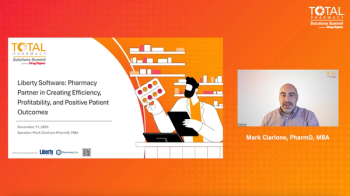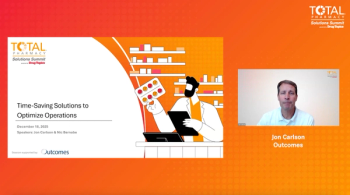
Greater PBM Leverage
Repercussions of PBM consolidation
Cover Story
A year after the merger between Express Scripts (ESI) and Medco Health Solutions, retail pharmacies - particularly independent pharmacies - are feeling considerable pressure from PBM practices.
Narrower pharmacy networks, lower reimbursements, more aggressive MAC (maximum acquisition costs) erosion, pharmacy benefit manager (PBM) transparency issues, mail-order, and PBM audits are taking a toll on independents trying to remain viable in this ever-changing healthcare marketplace.
Despite the Federal Trade Commission’s decision favoring the merger of ESI and Medco, the National Community Pharmacists Association (NCPA) still believes that the merger was anticompetitive, according to John Coster, PhD, RPh, NCPA senior vice president of government affairs.
“Over time the merger still remains a problem for patients, pharmacies, and the healthcare system,” Coster told Drug Topics. “Any time you put 60% of specialty drugs or mail-order drugs in the hands of one company, that is a problem.”
PBM consolidation has led to greater leverage in the marketplace, said Lonny Wilson, DPh, CEO and executive director of PPOK, an Oklahoma-based pharmacy services administrator organization. He is also the owner of three retail pharmacies in Oklahoma and immediate past president of NCPA.
ESI, Walgreens, and TRICARE
Walgreens, with 7,930 drug stores, the largest national chain, tried to negotiate a new contract renewal with ESI in 2011, but couldn’t reach an agreement and exited the ESI pharmacy provider network January 1, 2012. In July 2012, Walgreens and ESI signed a new, multiyear agreement to bring Walgreens back as of September 15, 2012. However, Walgreens was not included as a preferred pharmacy provider for one of ESI’s largest clients, TRICARE - the healthcare program serving the U.S. Department of Defense.
“Compared to fiscal 2011, we estimate that the negative impact of not being part of the Express Scripts, Inc. pharmacy provider network, net of associated cost reductions, was $0.21 per diluted share,” according to the 2012 Walgreens Annual Report.
Walgreens’ sales for fiscal year 2012 decreased by 0.8% compared to fiscal year 2011 and net earnings dropped by 21.6%, outlined in its annual report.
“Ultimately, the magnitude and timing of the impact on our financial results of rejoining the Express Scripts retail pharmacy provider network will depend on our ability to regain former patients and attract new patients covered by existing and new Express Scripts clients; however, we cannot predict with certainty what level of business we will achieve as a result of rejoining the Express Scripts retail pharmacy provider network in any particular future time period,” the 2012 Walgreens Annual Report stated.
Narrower networks, deeper discounts
Following its merger with Medco last year and settlement of its dispute with Walgreens, ESI has more than 65,000 pharmacies available to its health plan sponsors for employers, health plans, government entities, and unions.
Narrower pharmacy networks have allowed PBMs to offer improved discounts to their clients, the plan sponsors, said ESI, now the leading PBM in the industry. In 2012, ESI covered 100 million lives (about 40% of the market), managing 1.4 billion prescriptions for approximately 3,500 clients.
“If our clients clearly want to have access to retail pharmacy, they do,” said Brian Henry, ESI’s spokesman, in an interview with Drug Topics. “They can have access to a broad number of pharmacies or access to a narrower number of pharmacies, and that drives better discounts that way. They can utilize home delivery as an option, as well as a number of other solutions that we offer.”
Henry contended that optimizing the retail pharmacy network for the best value for its clients is part of the job for ESI and other PBMs. He believes that there is still healthy competition within the PBM industry, with approximately 50 PBMs operating in the PBM “space.” With the rise of healthcare costs, PBMs are able to do something about that, he said.
Preferred pharmacy networks
PBMs have created highly preferred pharmacy networks and forced independents to accept reimbursement levels below their acquisition costs or lose access to patients, Wilson said.
“As you look at the PBMs across the spectrum, the ones that have consolidated seem to have more aggressive MAC erosion than those that did not,” Wilson continued. “As they combine their platforms, they never combine their MAC tables from ones that are reasonable and attainable to the ones that are lower. I suspect what they do is take the lesser of the two entities that merged. So we have continued MAC erosion in the marketplace.”
Margin pressure is particularly acute for independent pharmacies, because 90% or more of their revenue comes from prescription sales. The big-box stores with pharmacies and the big chains may be able to offset lower prescription reimbursements with front-end sales, Wilson said.
“Independents don’t have a lot of margin for error on prescription revenues,” Coster said. “For independents, [PBM leverage] is like an 800-pound gorilla sitting on their lifeline - their prescription revenues. It may not happen all at once, but the consolidation accelerates the pace at which you will see margin pressure come on small pharmacies.”
Narrower networks for Medicare Part D beneficiaries may be benefitting only the plans and not saving money for the Centers for Medicare and Medicaid Services (CMS), Coster told Drug Topics.
“The scene on preferred networks is going to get blown off pretty soon because we have MedPac looking at them for Medicare Part D, and we have CMS questioning how they are operating under Medicare Part D,” Coster said.
At the beginning of March, NCPA responded to a draft call letter from CMS that outlined proposed policies for drug plans next year. NCPA expressed its concern about preferred pharmacy networks and asked CMS to further investigate and “ban ‘pay-to-play’ arrangements whereby pharmacies must pay $1.00 or more per claim to participate among a plan’s preferred pharmacies.”
Mid-level competition
Brian Bullock, president and CEO of the Burchfield Group, a consultant for health plan sponsors, said he believes the PBM industry is still competitive, with mid-tier players being quite aggressive in going after business.
In July 2012, Catamaran became the fourth-largest PBM, the result of a merger between SXC Health Solutions and Catalyst Health Solutions. It covers 30 million lives, which includes several million under Medicaid, or less than 4% of the marketplace.
“Catamaran has a strong combination of claims-processing and traditional PBM skills. They will be a formidable player and competitor against ESI and even CVS Caremark,” said Bullock in an interview with Drug Topics.
Coster believes that another PBM competitor is good for employers and the government; however, “with respect to its size compared to ESI, it is like spit in the ocean. I don’t know how much pressure that will bring on ESI in terms of how they treat pharmacies or the types of services they are going to provide.”
He noted that it would take a number of covered lives moving from either ESI or CVS Caremark -the No. 2 PBM in the industry, covering more than 85 million lives in 2011 (12% of market share) - to another competitor before a real competitor emerges.
“You don’t build that infrastructure over night,” Coster said.
NCPA takes on PBM industry
NCPA will continue to support legislation in 2013 that offers consumers greater choice of pharmacies, transparency in generic drug reimbursement calculations, and fairer standards for pharmacy audits at the federal and state levels, said CEO B. Douglas Hoey, RPh, MBA, in a prepared statement.
“The largest impediment to independent community pharmacies serving the needs of their patients is the bureaucratic morass they must wade through and the questionable business practices of often unregulated pharmacy benefit managers, which is why greater oversight of this industry is badly needed,” Hoey said in a February press statement.
Wilson agrees that independent pharmacies are facing big issues when it comes to working with the PBMs. When entering into a contract with PBMs, the MAC values are not clearly defined and independent pharmacies don’t know upfront how they are determined and what they are, Wilson said.
“We are told that this is proprietary. So it is kind of like the PBM is going to buy your car from you, but is not going to tell you what they will pay you. So sign here on the dotted line,” he said.
NCPA conducted a survey of its members in August 2012 that touched on the challenges that more than 350 pharmacies reported with PBMs. Approximately 96% of independent community pharmacists responding said that a typical contract had minimal or no transparency on how generic pricing was determined. About 20% of the time, the PBMs set generic reimbursements below the pharmacy’s acquisition cost. Almost 60% reported that PBM reimbursements and auditing practices were significantly affecting their ability to provide patient care and remain in business, according to NCPA’s March letter to CMS, addressing its proposed policies for drug plans next year.
Patient eligibility issues
Wilson noted that independent pharmacies have to contend with patient eligibility issues every January, and they may take several months to resolve. Sometimes pharmacy contracts are loaded into the system incorrectly. Also, when PBMs merge, they have to combine their claims-processing platforms, and patient-eligibility files are incorrect, resulting in denied claims, he said.
“The PBMs’ slow response time and customer support make it difficult for the pharmacist to verify patient eligibility. Sometimes they provide incorrect information or they can’t answer the question and say they will get back to you, and they never do,” Wilson said.
Wilson has followed up and called PBM management, outlining these difficulties, and in response has received commitments, yet the follow-through needed to get claims resolved is too slow, he said.
“This is almost March, and some of these promises that were made at the beginning of January have not been resolved relative to pharmacy contracts, reimbursement, and pricing,” Wilson said. “It makes it very difficult to stay focused on taking care of patients.”
PBM reform at the state level
Several states have seen some legislative activity in connection with greater PBM transparency, fairer PBM audit practices, and a leveling of the playing field with regard to mail order.
At the end of February, the Kentucky Senate passed S.B. 107, Maximum Allowable Costs for Pharmaceuticals, a bill intended to provide transparency about the way pharmacy reimbursements are determined for multiple source generic drugs and to establish a fairer appeals process when pharmacies dispute the MAC list levels.
According to NCPA, that lack of transparency benefits the PBMs, which will keep two different MAC lists for the same prescription drug health plan - one for the health plan sponsor and one for the pharmacies. Pharmacies are reimbursed at a lower rate based on an aggressively low MAC price list, while the plan sponsors see a higher MAC price list. The difference, known as spread pricing, is then pocketed by the PBM, NCPA noted.
In Oregon, community pharmacists are also asking their state lawmakers to support a legislative proposal that would provide greater transparency for determining MAC values that PBMs pay pharmacies (S.B. 402). In addition, they are supporting legislation for fairer pharmacy audit standards (H.B. 2123), which would require that PBMs register and be licensed by the Oregon State Board of Pharmacy, and S.B. 363 that would allow patients in Oregon to choose where they want to fill their prescriptions, without the risk of higher costs.
Mandatory mail order has also posed problems for independents in other states.
In Oklahoma, Wilson worked to stop mandatory mail order for all maintenance medications when it was under consideration by the Oklahoma State and Education Employees Group Insurance Board in late 2011. Wilson countered the PBM’s aggressive marketing and benefit design with aggressive reimbursement rates for 90-day dispensing at retail.
“We ran all the actuarial studies, and the state’s actuarial consultant confirmed our findings that we [independent pharmacies] would save the state of Oklahoma more money than they could with mail order,” Wilson said.
The PBM reported a savings of $15.1 million with mandatory mail order, but the community pharmacy proposal - with discounts for both 30-day brand and generics, a 90-day retail option with more discounts, and elimination of copay penalties - resulted in savings of $32.9 million.
“This has effectively eliminated mail-order market penetration and provided the state plan much greater savings at reimbursement rates that are attainable and profitable for all community pharmacies,” Wilson said.
Connected with mail order has been heavy use of the auto-fill component, which has resulted in pharmaceutical waste. NCPA advocates CMS development of clear policies and parameters for auto-ship refill programs. While NCPA favors the CMS requirement that patient consent be obtained before each refill or new prescription, the organization prefers that CMS go further, with elimination of blanket consent agreements.
“The PBM owns the mail-order company, so look at what the mail-order pharmacy gets paid. They are going to pay themselves a higher rate,” said Wilson. “They [PBMs] dangle the deep discount on brand-name drugs, yet auto-fill drives up waste with high costs, and they are paying themselves a much higher rate than they pay retail [pharmacies].”
PBM audits
NCPA says that it supports legitimate auditing practices undertaken by PBMs to uncover true fraud and abuse. However, an NCPA survey conducted last fall indicated that almost 80% of independent pharmacies reported that PBMs apply inconsistent auditing standards across various plans. Also, more than 80% reported that PBM auditors “always” or “often” required recordkeeping above and beyond the requirements of state and federal law.
“Most significantly, almost 87% of respondents reported that PBM auditing practices have a ‘significant’ to ‘very significant’ impact on respondents’ ability to provide patient care and remain in business, which can lead to decreased access to care,” NCPA noted in its March response to CMS, discussing its proposed policies for drug plans next year.
In Wilson’s own experience, a PBM recovery of $20,000 from his pharmacy was based on clerical errors.
“These were valid claims, and somebody transposed two numbers or the doctor gave the pharmacy the wrong NPI. That should not invalidate the prescription,” he said. “This is not fraud, waste, or abuse. This is about PBMs finding another revenue source.”
Health insurance exchanges
Next year, under the Affordable Care Act, consumers will be able to obtain health insurance coverage through health insurance exchanges. The Congressional Budget Office estimates that with increased access to affordable insurance, approximately 32 million more Americans will have insurance benefits by 2019.
PBMs, retail pharmacies, mail-order pharmacies, and pharmacists in general can all benefit from this new opportunity driven by healthcare reform, according to David Calabrese, RPh, MHP, vice president and chief pharmacy officer of Catamaran.
The expanding market will provide access to more patients with pharmacy benefits, and an aging population and an increase in chronic disease will cause demand to grow, he said.
“With the different delivery models, such as co-ops, health insurance exchanges, accountable care organizations, and patient-centered medical homes, there will be a greater emphasis on keeping people healthy, wellness programs, and preventative care programs, as opposed to focusing on just how to treat disease,” Calabrese said.
“We want to prevent disease to begin with, as a way to help lower healthcare costs and decrease financial burden for the clients that we support,” he added.
Where things stand
Catamaran’s plan is to work to expand its regional approach as it seeks a better understanding of the local healthcare marketplace and local provider-patient dynamics, with the goal of providing a higher level of customer support and service. Its focus will include outcomes-driven support to help clients, patients, and providers manage “the most significant growing component of the healthcare dollar - specialty medications.”
Catamaran believes that it has had good relationships with the retail pharmacies it works with across the country and has dealt with them in a fair and equitable manner when dealing with reimbursement.
ESI maintains that there is still healthy growth taking place within retail pharmacy and healthy competition in the PBM space.
NCPA will continue to advocate for PBM transparency and fairer PBM audit practices, said Coster.
“Several states, like North Dakota, Kentucky, Alaska, and Oregon, voiced real opportunity to enact PBM reform. Nothing is signed into law, but it is in various stages of movement through the process,” Coster said. “Those are the states where we are optimistic that we will overcome the PBM lobby.”
Newsletter
Pharmacy practice is always changing. Stay ahead of the curve with the Drug Topics newsletter and get the latest drug information, industry trends, and patient care tips.











































































































































































































